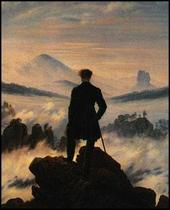Extended Banner Editor
MySpace Editor
MySpace Layouts
Glitter Graphics
MySpaceCaspar David Friedrich (September 5, 1774 – May 7, 1840) was a 19th century German romantic painter, considered by many critics to be one of the finest representatives of the movement.Caspar David Friedrich was born in Greifswald, Hither Pomerania. Relevant as a background to his work are the strict Lutheran creed of his father and his early familiarity with death: his mother died when he was seven, his sister succumbed to typhus fever and his brother drowned in a frozen lake, allegedly while trying to save Friedrich, under whose feet the ice had cracked. In 1790 he began studying art with Johann Gottfried Quistorp at the University of Greifswald and literature and aesthetics from Swedish professor Thomas Thorbild.In 1794 he entered the prestigious Academy of Copenhagen, and in 1798 he settled in Dresden. He often painted with India ink, watercolor and sepia ink, which is said to require particular skills, thus gaining him the attention of critics. It is unclear when he finally took up oil painting, but it was surely after the age of 30. Landscapes were his preferred subject. Mostly based on those of northern Germany, they depict woods, hills, harbors, morning mists and other light effects based on a close observation of nature.In 1808, a time when Friedrich was growing in popularity, he exhibited one of his most controversial paintings, The Cross in the Mountains (Gemäldegalerie, Dresden). For the first time in Christian art, an altarpiece was represented in terms of pure landscape. The cross, viewed obliquely from behind, is an insignificant element in the composition. More important are the dominant rays of the evening sun, which the artist said depicted the setting of the old, pre-Christian world. The mountain symbolizes an immovable faith, while the fir trees are an allegory of hope. Friedrich painted several other important compositions in which crosses dominate a landscape.
Chalk Cliffs on Rügen, 1818.He was acquainted with Philipp Otto Runge, another notable German painter of the Romantic period, and gained the admiration of the poet Goethe. He was also a friend of Norwegian painter Johann Christian Dahl and Georg Friedrich Kersting. In 1810 he became a member of the Academy of Berlin. In addition to Christianty, references to German folklore became increasingly prominent, underscoring Friedrich's patriotism during the French occupation of Pomerania. Following his marriage to Caroline Bommer in 1818, he began to frequently portray feminine characters in his paintings. Cretacic Rocks in Rügen, painted during his honeymoon, is a good example of this development.With dawns and dusks constituting and important part of his landscapes, Friedrich's own dusk years were characterized by a growing pessimism. This is reflected in his work, which becomes darker, showing a fearsome monumentalism. The Sea of Ice perhaps summarizes the Friedrich's ideas and aims at this point, though in such a radical way that the painting not well received. Between 1830-1835 he became more reclusive, and he notably dismissed the opinions of critics and the public by only painting for his family and friends, although this can be considered one of his finest periods. In 1835, a stroke caused him limb paralysis and he was unable to paint ever again.
(text taken by Wikipedia)
